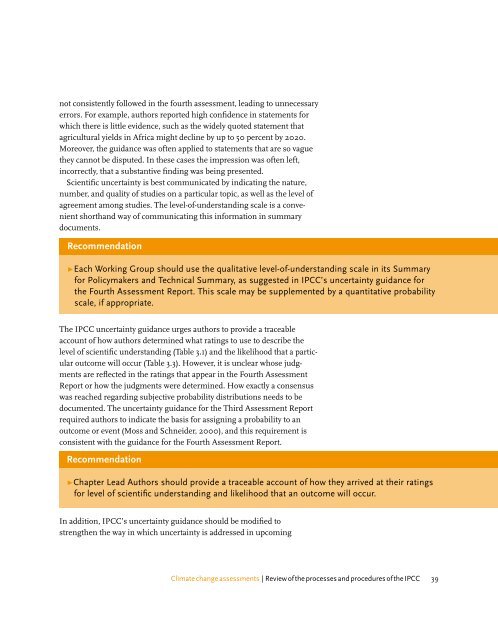Climate change assessments Review of the processes and ...
Climate change assessments Review of the processes and ...
Climate change assessments Review of the processes and ...
Create successful ePaper yourself
Turn your PDF publications into a flip-book with our unique Google optimized e-Paper software.
not consistently followed in <strong>the</strong> fourth assessment, leading to unnecessary<br />
errors. For example, authors reported high confidence in statements for<br />
which <strong>the</strong>re is little evidence, such as <strong>the</strong> widely quoted statement that<br />
agricultural yields in Africa might decline by up to 50 percent by 2020.<br />
Moreover, <strong>the</strong> guidance was <strong>of</strong>ten applied to statements that are so vague<br />
<strong>the</strong>y cannot be disputed. In <strong>the</strong>se cases <strong>the</strong> impression was <strong>of</strong>ten left,<br />
incorrectly, that a substantive finding was being presented.<br />
Scientific uncertainty is best communicated by indicating <strong>the</strong> nature,<br />
number, <strong>and</strong> quality <strong>of</strong> studies on a particular topic, as well as <strong>the</strong> level <strong>of</strong><br />
agreement among studies. The level-<strong>of</strong>-underst<strong>and</strong>ing scale is a convenient<br />
shorth<strong>and</strong> way <strong>of</strong> communicating this information in summary<br />
documents.<br />
Recommendation<br />
►Each Working Group should use <strong>the</strong> qualitative level-<strong>of</strong>-underst<strong>and</strong>ing scale in its Summary<br />
for Policymakers <strong>and</strong> Technical Summary, as suggested in IPCC’s uncertainty guidance for<br />
<strong>the</strong> Fourth Assessment Report. This scale may be supplemented by a quantitative probability<br />
scale, if appropriate.<br />
The IPCC uncertainty guidance urges authors to provide a traceable<br />
account <strong>of</strong> how authors determined what ratings to use to describe <strong>the</strong><br />
level <strong>of</strong> scientific underst<strong>and</strong>ing (Table 3.1) <strong>and</strong> <strong>the</strong> likelihood that a particular<br />
outcome will occur (Table 3.3). However, it is unclear whose judgments<br />
are reflected in <strong>the</strong> ratings that appear in <strong>the</strong> Fourth Assessment<br />
Report or how <strong>the</strong> judgments were determined. How exactly a consensus<br />
was reached regarding subjective probability distributions needs to be<br />
documented. The uncertainty guidance for <strong>the</strong> Third Assessment Report<br />
required authors to indicate <strong>the</strong> basis for assigning a probability to an<br />
outcome or event (Moss <strong>and</strong> Schneider, 2000), <strong>and</strong> this requirement is<br />
consistent with <strong>the</strong> guidance for <strong>the</strong> Fourth Assessment Report.<br />
Recommendation<br />
►Chapter Lead Authors should provide a traceable account <strong>of</strong> how <strong>the</strong>y arrived at <strong>the</strong>ir ratings<br />
for level <strong>of</strong> scientific underst<strong>and</strong>ing <strong>and</strong> likelihood that an outcome will occur.<br />
In addition, IPCC’s uncertainty guidance should be modified to<br />
streng<strong>the</strong>n <strong>the</strong> way in which uncertainty is addressed in upcoming<br />
<strong>Climate</strong> <strong>change</strong> <strong>assessments</strong> | <strong>Review</strong> <strong>of</strong> <strong>the</strong> <strong>processes</strong> <strong>and</strong> procedures <strong>of</strong> <strong>the</strong> IPCC 39

















